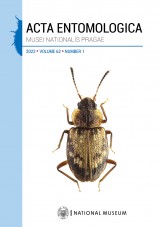Review of the genera Elaphinis and Parelaphinis (Coleoptera: Scarabaeidae: Cetoniinae) with description of three new species from South Africa
Perissinotto Renzo
Acta Entomologica Musei Nationalis Pragae 62(1): 35-55, 2022
Published online: 30th April 2022
Views: 1952
Abstract: The cetoniine genera Elaphinis Burmeister, 1842 and Parelaphinis Marais &
Holm, 1989 are reviewed in the light of substantial new material that has
become available recently. A new species, E. matatiele sp. nov., in the
previously monotypic subgenus Elaphinis s. str. and closely related to E. (E.)
cinereonebulosa (De Geer, 1778), is described from the southern Drakensberg area
near Matatiele (Eastern Cape, South Africa). Within Parelaphinis, two new
species, P. umtamvuna sp. nov. and P. drakensbergica sp. nov. are described and
compared with P. moesta (Gory & Percheron, 1833) – hitherto the only
member of the genus. The former is a mid- to lowland dweller, currently known
only from the KwaZulu-Natal side of the Umtamvuna River valley (South Africa).
The latter is a montane species apparently distributed across the eastern
portion of the Drakensberg Escarpment, from the north-eastern Free State (South
Africa) to eSwatini (formerly Swaziland). A review of the enigmatic species E.
(Micrelaphinis) pumila Boheman, 1857, also presumably originating from the same
broader region, reveals that only five specimens, three of which belong to the
type series, are currently still traceable to accessible collections, while no
further specimens have been found since the 19th century. It is here established
that the type series collected by Wahlberg during the period 1838–1845 most
likely originated from the Orange River valley, either in the Eastern Cape, Free
State or Lesotho. As this area has been extensively transformed by agricultural
and mining activities, as well as human settlements, it is hypothesized that the
species may already be extinct. All the species analysed in detail are
illustrated, and dichotomic keys to all species of both genera are provided to
facilitate their identification.
Key words: Coleoptera, Scarabaeidae, Cetoniini, new species, Southern Africa, Afrotropical Region
Papers
This issue is dedicated to Aleš SmetanaNew and little-known species of the genus Dicerapanorpa from northwestern Yunnan, China (Mecoptera: Panorpidae)A new Copelatus with small eyes from the Eastern Cape Wild Coast, South Africa (Coleoptera: Dytiscidae)Morphology of the larvae and biology of the adults of Psilorrhynchus bifasciatus do not confirm previous hypotheses about systematics and feeding habits (Coleoptera: Cantharidae)Review of the genera Elaphinis and Parelaphinis (Coleoptera: Scarabaeidae: Cetoniinae) with description of three new species from South AfricaThe ̒first fossil tumbling flower beetle’ larva is a symphytan (Hymenoptera)Revision of the genera of Picrotini (Coleoptera: Cryptophagidae: Cryptophaginae)First record of the genera Bulborhodopis and Mimapatelarthron from China, with description of one new species (Coleoptera: Cerambycidae)Two new species of the genus Omoplax (Hemiptera: Heteroptera: Tingidae) from Mukojima Island, with new records of lace bugs endemic to the Ogasawara Islands, JapanDiscovery of mysterious Pakistatyrus in Tibet (Coleoptera: Staphylinidae: Pselaphinae)Taxonomy of the intertidal athetine genus Eubadura stat. nov. (Coleoptera: Staphylinidae: Aleocharinae) from Japan, with descriptions of two new speciesTaxonomic notes on the Indian assassin bug Ectomocoris simulans (Hemiptera: Heteroptera: Reduviidae) with two new synonymsLeiodidae (Coleoptera) of the Hainan Island with new faunistic records from China and with notes on the unique body modifications in the genus AgathidiumA review of the genus Psammocrуptus (Coleoptera: Tenebrionidae: Tentyriini)Two new species of Xenos (Strepsiptera: Xenidae), parasites of social wasps of the genus Mischocyttarus (Hymenoptera: Vespidae) in the New WorldMorphology of larvae and pupae of the genus Autocrates (Coleoptera: Trictenotomidae) and its phylogenetic implicationsDrymini of Madagascar, with description of a new genus and three new species (Hemiptera: Heteroptera: Rhyparochromidae)Revision of Quedius sensu stricto (Coleoptera: Staphylinidae) 